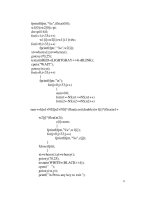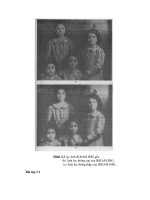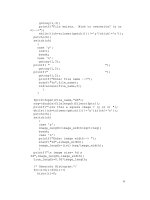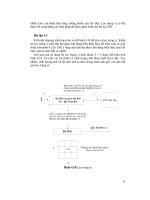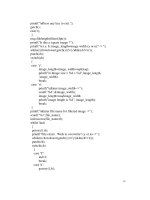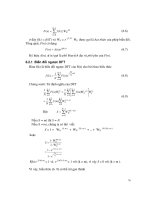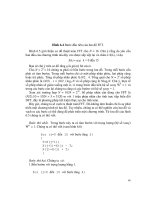Giáo trình xử lý ảnh y tế Tập 1a P14 docx
Bạn đang xem bản rút gọn của tài liệu. Xem và tải ngay bản đầy đủ của tài liệu tại đây (186.65 KB, 10 trang )
116
int iter,i,k;
int k1,inc1;
int k2,j,k3,k4;
char *buff1,*buff2,tmp;
long loc;
buff1=(char *)malloc(N*sizeof(char));
buff2=(char *)malloc(N*sizeof(char));
N1=N/2;
inc=1;
inc1=2;
00 02 04 06
11 13 15 17
20 22 24 26
01 03 05 07
10 12
14
16
21 23 25 27
30 32 34 36
41 43 45 47
50 52
54 56
31 33 35 37
40 42 44 46
51 53 55 57
61 63 65 67
70
72
74 76
60 62 64 66
71 73 75 77
41
43
50
52
40
42
51
53
61
63
70
72
60
62
71
73
bíc 0 bíc 2
04
06
15
17
24
26
05
07
14
16
25
27
34
36
35
37
00
02
11
13
20
22
01
03
10
12
21
23
30
32
31
33
45
47
54
56
44
46
55
57
65
67
74
76
64
66
75
77
00
02
04
06
11
13
15
17
20
22
24
26
01
03
05
07
10
12
14
16
21
23
25
27
30
32
34
36
41
43
45
47
50
52
54
56
31
33
35
37
40
42
44
46
51
53
55
57
61
63
65
67
70
72
74
76
60
62
64
66
71
73
75
77
00
11
01
10
02
13
03
12
04
1505
14
06
17
07
16
20
21
30
31
22
23
32
33
24
25
34
35
26
27
36
37
41
50
40
51
43
52
42
53
45
5444
55
47
56
46
57
61
70
60
71
63
72
62
73
65
7464
75
67
76
66
77
bíc 1 Ma trËn chuyÓn vÞ
117
Hình 6.10 Thuật toán của Eklundh cho dịch chuyển một ma trận.
for(iter=0;iter<n;iter++)
{
gotoxy(1,2);
printf("iteration # %4d",iter+1);
k1=0 ;
for(k=0;k<N1;k++)
{
for(i=k1;i<(k1+inc);i++)
loc=(long)(N)*(long)(i);
if(fseek(fptr,loc,SEEK_SET)!=0)
{
perror("fseek failed");
exit(1);
}
else
{
gotoxy(1,3);
printf("Reading row # %4d",i);
for(k4=0;k4<N;k4++)
*(buff1+k4)=fgetc(fptr);
{
loc=(long)(N)*(long)(i+inc);
}
if(fseek(fptr,loc,SEEK_SET)!=0)
{
perror("fseek failed");
exit(1) ;
}
else
{
gotoxy(1,4);
printf("Reading row # %4d",i+inc);
for(k4=0;k4<N;k4++)
*(buff2+k4)=fgetc(fptr);
}
k3=0;
for(k2=0;k2<N1;k2++)
{
118
for(j=k3;j<(k3+inc);j++)
{
tmp=*(buff1+j+inc);
*(buff1+j+inc)=*(buff2+j);
*(buff2+j)=tmp;
}
k3+=inc1 ;
}
loc=(long)(N)*(long)i;
if(fseek(fptr,loc,SEEK_SET)!=0)
{
perror("fseek failed");
exit( 1 ) ;
}
else
{
gotoxy(1,3);
printf("writing row # %4d",i);
for(k4=0;k4<N;k4++)
putc((char)(*(buff1+k4)),fptr);
}
loc=(long)(N)*(long)(i+inc);
if(fseek(fptr,loc,SEEK_SET)!=0)
{
perror("fseek failed");
exit(1) ;
}
else
{
gotoxy(1,4);
printf("writing row # %4d",i+inc);
for(k4=0;k4<N;k4++)
putc((char)(*(buff2+k4)),fptr);
}
}
k1+=inc1 ;
}
inc*=2;
119
inc1*=2;
N1/=2;
}
Để kiểm tra chương trình 6.5 chúng ta sẽ áp dụng thuật toán này lên ảnh cho
trong hình 6.11. ảnh này chứa trên đĩa đi kèm theo cuốn sách này dưới file có tên
là “MOHSEN.IMG”.
Chương trình 6.6 “ FFT2D.C” 2-D FFT
/******************************
* Program developed by: *
* M.A.Sid-Ahmed. *
* ver. 1.0 1992. *
* @ 1994 *
******************************/
/* 2D-FFT - Using Decimation-in-time routine.*/
#define pi 3.141592654
#include <stdio.h>
#include <math.h>
#include <alloc.h>
#include <stdlib.h>
#include <io.h>
#include <conio.h>
void bit_reversal(unsigned int *, int , int);
void WTS(float *, float *, int, int);
void FFT(float *xr, float *xi, float *, float *, int,
int ) ;
void transpose(FILE *, int, int);
void FFT2D(FILE *, FILE *, float *, float*, unsigned
int *,int,int,int);
120
Hình 6.11 Ảnh đã được dịch chuyển, "MOHSEN.IMG".
void main()
{
int N,n2,m,k,i;
unsigned int *L;
float *wr , *wi;
char file_name[14];
FILE *fptr,*fptro;
double nsq;
clrscr();
printf(" Enter name of input file-> ");
scanf("%s",file_name);
if((fptr=fopen(file_name,"rb"))==NULL)
{
printf("file %s does not exist.\n");
exit(1);
}
nsq=(double)filelength(fileno(fptr));
N=sqrt(nsq);
m=(int)(log10((double)N)/log10((double)2.0));
k=1 ;
121
for(i=0;i<m;i++)
k<<=1 ;
if (k!=N)
{
printf("Length of file has to be multiples of 2.\n
");
exit(1);
}
Hình 6.12 Ảnh dịch chuyển của “MOHSEN.IMG”.
printf(" Enter file name for output file >");
scanf("%s",file_name);
fptro=fopen(file_name,"wb+");
/* Allocating memory for bit reversal LUT. */
L=(unsigned int *)malloc(N*sizeof(unsigned int));
/* Generate Look-up table for bit reversal. */
bit_reversal(L,m,N);
/* Allocating memory for twiddle factors. */
n2=(N>>1)-1;
wr=(float *)malloc(n2*sizeof(float));
122
wi=(float *)malloc(n2*sizeof(float));
/*Generating LUT for
twiddle factors. */
WTS(wr,wi,N,-1);
FFT2D(fptr,fptro,wr,wi,L,N,m,-1);
}
void FFT2D(FILE *fptr, FILE *fptro,
float *wr, float *wi, unsigned int *L,
int N, int m, int sign)
{
/* 2-D FFT Algorithm. */
/* fptr=file pointer to input file.
fptro=file pointer to output file.
Note: fptr, fptro should be opened in the main
routine. They are closed before return to @he main
routine.
wr[1,wj[I input arrays for twiddle factors, calculated
by calling procedure WTS.
L[I look-up table for bit reversal. N input array
size ( NxN words.) =2 to the power m.
sign =-1 for 2-D FFT,
=1 for 2-D IFFT.
For FFT (sign= 1) the input data is assumed to be
real.
The result of the FFT has its origin shifted to
(N/2,N/2).*/
int N2,i,j,k,kk;
long loc,NB;
float *xr,*xi,*buff;
N2=N<<1;
NB=sizeof(float)*N2;
/* Allocating memory for FFT arrays ( real and imag.)
*/
xr=(float *)malloc(N*sizeof(float));
xi=(float *)malloc(N*sizeof(float));
buff=(float *)malloc(NB);
123
/* First stage. */
gotoxy(1,3);
printf(" First stage. ");
for(j=0;j<N;j++)
{
gotoxy(1,4);
printf("FFT of row %4d",j);
if(sign==(int)1)
{
fread(buff,NB,1,fptr);
for(i=0;i<N;i++)
{
k=L[i] ;
kk=i<<1 ;
xr[k]=buff[kk];
xi[k]=buff[kk+1];
}
}
else
{
for(i=0;i<N;i++)
{
k=L[i] ;
xr[k]=(float)getc(fptr);
if(((i+j)%2)!=0) xr[k]=-xr[k];
xi[k]=0.0;
}
}
FFT(xr,xi,wr,wi,m,N);
for(i=0;i<N;i++)
{
k=i<<1;
buff[k]=xr[i];
buff[k+1]=xi[1];
}
fwrite(buff,NB,1,fptro);
}
fclose(fptr);
/* Transpose. */
gotoxy(1,5);
124
printf(" Transposing of intermediate file. ");
rewind(fptro);
transpose(fptro,N,m);
rewind(fptro);
/* Second stage. */
printf("\n Second stage.");
for(j=0;j<N;j++)
{
gotoxy(1,7);
printf("FFT of row %4d",j);
loc=(long)j*NB;
fseek(fptro,loc,SEEK_SET);
fread(buff,NB,1,fptro);
for(i=0;i<N;i++)
{
k=L[i] ;
kk=i<<1 ;
xr[k]=buff[kk];
xi[k]=buff[kk+1];
}
FFT(xr,xi,wr,wi,m,N);
for(i=0;i<N;i++)
{
k=i<<1 ;
if((sign==(int)1)&&((i+j)%2)==(int)0)
{
buff[k]=-xr[i];
buff[k+1]=-xi[i];
}
else
{
buff[k]=xr[i];
buff[k+1]=xi[i];
}
}
if(fseek(fptro,loc,SEEK_SET)!=0)
{
perror("\n fseek failed.\n");
exit(1) ;
}
125
fwrite(buff,NB,1,fptro);
}
fclose(fptro);
}
void FFT
(float *xr, float *xi, float *wr, float *wi, int m,
int N)
{
/* FFT algorithm.
Decimation-in-time algorithm.
Note:
1. N=2 to the power of m.
2. The input arrays are assumed to be rearranged in
bit-reverse order.
You will need to use routine "bit-reversal" for
that purpose.
3. The twiddle factors are assumed to be stored in
LUT's wr[] and wi[].
You will need to use routine LUT for calculating
and storing twiddle factors.
*/
int ip,k,kk,l,incr,iter,i,j;
float Tr,Ti;
ip=1;
kk=(N>>1);
incr=2 ;
for(iter=0; iter<m; iter++)
{
for(j=0; j<N; j+=incr)
{
i=j+ip;
Tr=xr[i] ;
Ti=xi[i] ;
xr[i]=xr[j]-Tr;
xi[i]=xi[j]-Ti;

